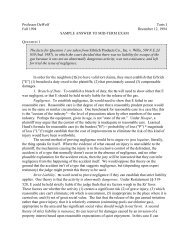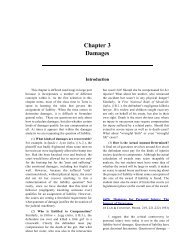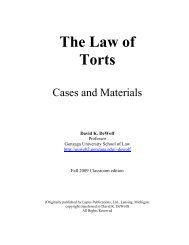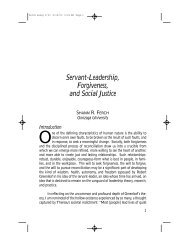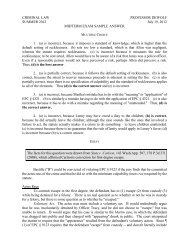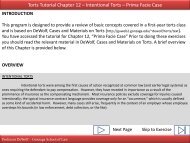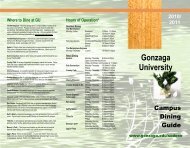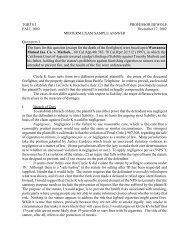sample answer
sample answer
sample answer
You also want an ePaper? Increase the reach of your titles
YUMPU automatically turns print PDFs into web optimized ePapers that Google loves.
TORTS II<br />
PROFESSOR DEWOLF<br />
SUMMER 2000 August 7, 2000<br />
FINAL EXAM SAMPLE ANSWER<br />
QUESTION 1<br />
The facts for this question were based upon Seymour v. Brunswick Corp., 655 So.2d 892 (Miss.<br />
1995), in which the court reversed a summary judgment for the defendant boat manufacturer,<br />
finding that the plaintiff's knowledge of the danger did not foreclose a claim based upon a riskutility<br />
analysis.<br />
I would anticipate product liability claims brought by Beth (and possibly by her stepfather<br />
and mother) based on the failure of the motor to have either a propeller guard or a warning about the<br />
danger posed by the motor.<br />
Product Liability Theories<br />
In order to recover, Beth 1 would have to show that the product was defective. A product<br />
may be defective by reason of (1) manufacturing; (2) design; or (3) lack of adequate warning. There<br />
is no showing that the product was defective in manufacture, but there might be claims that the<br />
product was defective in design or in failure to warn.<br />
Design. Courts are divided in how to evaluate an alleged design defect. Here Beth would be<br />
claiming that the product was defective because it allowed her foot to be mangled in the propeller,<br />
and that a reasonably safe design would prevent such an event from occurring. Some courts have<br />
applied a consumer expectations test that focuses on what a reasonable consumer would expect, and<br />
Beth would then argue that she did not expect to suffer this injury. Fortunately for us, she has<br />
admitted that she knew about the propeller turning even when the boat was idling, and so her claim<br />
under a consumer expectations test would be weak. However, the test is not necessarily what this<br />
particular consumer expected, but what a reasonable consumer would expect in her position. It<br />
might be that it's so dangerous that it's unreasonbly dangerous even though Beth happened to know<br />
about its danger. Still, if the consumer expectations test is used, it's good for us. On the other hand,<br />
many jurisdictions (and the newly issued Restatement (3d)) recommend use of a risk-utility test to<br />
evaluate whether the product is unreasonably dangerous. This test is in effect a kind of negligence<br />
test, balancing the potential risks against the cost of making the product safer. 2 To hold us liable<br />
under a risk-utility test, Beth would have to show that a reasonable designer would have redesigned<br />
the propeller so that it didn't turn when it was in idling mode, or that it would have some kind of<br />
guard on it to keep injuries like this from occurring. I don't know how expensive it would be to add<br />
such a feature, or how it would interfere with performance. We would probably be able to find a<br />
designer who could testify on the loss in terms of performance or extra cost that a redesign would<br />
entail. On the other hand, the plaintiff is likely to find an expert who will say that such a redesign<br />
would be worth it given the number of injuries suffered by people like Beth.<br />
1. Or anyone else wanting to recover from us, like her stepfather or mother.<br />
2. If there is newly acquired knowledge about the product's dangers, many courts will allow that<br />
knowledge to be used in evaluating whether a reasonable person would have put the product in the<br />
stream of commerce as designed if such a designer knew at the time of the dangerous we have since<br />
learned about. That use of "20-20 hindsight" is a form of strict liability.
DeWolf, Torts II, Summer 2000, Sample Answer Page 2<br />
Warning. Beth would probably also assert that the product was defective in failing to<br />
provide adequate warning of the product's dangers. The difficulty for her would be to show that<br />
some kind of warning could have been given that would have made a difference. Even if a warning<br />
were placed on the motor or on the boat or in the owner's manual, it is hard to see how it could have<br />
prevented this injury.<br />
Statute of Repose. As a remote possibility, the age of the boat (17 years on the day of the<br />
accident) might trigger a statute of repose, if the jurisdiciton has one.<br />
Contributory Fault Issues<br />
If Beth succeeded in proving that the product was defective, her claim would be limited or<br />
possibly barred by her own contributory fault. Under Linden statutes, LSA § 1A.1, Beth's claim<br />
would be barred if she were found more than 50% at fault. The statute seems to provide that her<br />
claim would be barred if her negligence is greater than that of a person "causing such damage," or of<br />
it is greater than the combined negligence of the persons causing the damage. I'm not sure what that<br />
means. 3 A second defense would be that Beth assumed the risk of injury. She knew about the danger<br />
of the propeller, and encountered it anyway. As to this claim, it would probably be a simple case of<br />
contributory negligence, and there would be no need for separate instruction. On the other hand, we<br />
might assert that her decision to go inner-tubing behind a speedboat is an additional assumption of<br />
risk, like skiing or doing pyramid stunts, which has an inherent risk that should be used as a form of<br />
comparative fault, or possibly to bar the claim entirely. I don't think a court would use this to bar her<br />
claim, but we should ask for a separate instruction on assumption of risk.<br />
Comparative Fault<br />
We will argue that not only was Beth at fault, but so was Danny, her stepfather. He drove<br />
the boat in such a way that it confused her into thinking it was safe for her to climb in. He should<br />
have turned off the engine or maneuvered the boat so it wouldn't run over Beth.<br />
One problem for us will be the potential for an immunity claim. As Beth's stepfather, Danny<br />
would be entitled to parental immunity, but only for those functions that are unique to parenting.<br />
We would argue that Danny's negligence was in a non-parental role (that of driving a boat) and that<br />
he would be a proper defendant. Even if the jury finds that our product was defective, they are likely<br />
to find that Danny was substantially at fault. In addition, however, Danny may have some<br />
responsibility for failing to properly supervise or instruct his stepdaughter. For this claim there<br />
would be parental immunity<br />
Linden has adopted a comparative fault statute (based on Washington's) that makes the<br />
defendants liable for the collective shares of liability but only if the plaintiff is found to be not at<br />
fault. If the jury agrees that Beth was negligent, then she could only recover our percentage share of<br />
liability. If the jury found Beth was not at fault, then we would be liable for our percentage along<br />
with the percentage of any other defendant against whom a judgment was entered.<br />
3. Oklahoma's statute, from which this language is taken, has been interpreted to allow a plaintiff<br />
to recover so long as the plaintiff's negligence is not greater than the combined negligence of the<br />
defendants and any third-party tortfeasors.
DeWolf, Torts II, Summer 2000, Sample Answer Page 3<br />
Bystander/Consortium Claims<br />
The bad news is that, if we were found at fault, there might be additional claims from Danny<br />
and possibly Julie. Most jurisdictions permit recover for someone who is a witness at an accident<br />
scene to gruesome injury, and particularly in this case where it is a child (albeit a stepchild). Danny<br />
might assert such a bystander claim. Some jurisdictions even permit recovery for loss of society and<br />
companionship to parents, even if they are not present at the accident scene. Thus, Julie might make<br />
a claim as Beth's mother, but I don't think she'd be likely to recover. Also, Danny's negligence<br />
would offset any recovery to which he'd otherwise be entitled.<br />
Statute of Limitations<br />
The instructions indicate that the plaintiff's lawyer has sent a letter demanding payment, but<br />
nothing is said about a complaint having been filed. Many jurisdictions have a statute of limitations<br />
of three years or less, and if there is no complaint filed by August 8, 2000, the claim may be barred<br />
by the statute of limitations. In most jurisdictions the statute of limitations will be tolled for a minor;<br />
however, it is not tolled for an adult, such as Danny or Julie<br />
QUESTION 2<br />
Some of the facts for this question were based upon State v. Estate of Horton, 4 S.W.3d 53<br />
(Tex.App. 1999), in which the appellate court dismissed the case based upon a provision in the<br />
sovereign immunity statute relating to acts done prior to 1970.<br />
This claim would be brought against the state as a wrongful death claim. Because of the<br />
limitations in the sovereign immunity statute, it will be difficult to establish liability. It seems<br />
relatively easy to establish that, if this were a private park, Joel Sr. would be an invitee and entitled<br />
to expect reasonable care in the maintenance of the lake area. Our expert seems prepared to testify<br />
that there was negligence in the way the swimming area was maintained. However, again the<br />
sovereign immunity statute places limitations on any recovery.<br />
The Sovereign Immunity Statute<br />
Linden has apparently adopted sovereign immunity as a principle, but has simultaneously<br />
agreed to a waiver of that liability for certain purposes (§§ 152.1A-.1B). One major limitation is that<br />
the maximum for any single claimant is $100,000 (§ 154A(2)). As we shall see, it is possible to<br />
consider the estate a separate claimant from Joel, Jr., thus making it possible that two awards of<br />
$100,000 each could be made. However, that would be the maximum. Moreover, the state's<br />
liability is several only (§ 154F), so that if some other entity (like Joel Jr.) is found to be at fault, the<br />
state would be liable only for the percentage it is found to be at fault.<br />
There are some troubling exceptions to liability. § 155(10) exempts from liability "natural<br />
conditions"; however, we could argue that by making the lake a swimming area, the state has<br />
removed that part of the lake from being a natural condition. In addition, § 154(13) forbids liability<br />
for "negligent inspection. I would argue that it is not the negligence in inspection that caused the<br />
problem, but rather the failure to promptly repair it or warn of the condition. § 155(15) exempts<br />
from liability a "failure to warn," but it seems to be limited to highway signs and warnings.<br />
Assuming we could survive these exemptions, the state could be found liable for Joel Sr.'s
DeWolf, Torts II, Summer 2000, Sample Answer Page 4<br />
death.<br />
Damages<br />
The wrongful death statute, § 28A-18-1, is in the form of a survival statute; that is, the<br />
recovery goes to the estate of the decedent. I'm assuming that Joel Jr. is a beneficiary of that estate,<br />
although he might have to share it with other children of Joel Sr. I'm also assuming there is no Mrs.<br />
Joel Sr., who would also have rights under the statute to any recovery by the estate.<br />
The statute provides for recovery of economic loss from lost income, which would likely be<br />
neglible in this case, since Joel Sr. seems pretty incapacitated. However, it does allow for loss of<br />
society and companionship. I don't think Joel Jr. and Sarah would have much difficulty showing<br />
that the loss of Joel Sr.'s society and companionship was significant -- as much as the $100,000<br />
limitation by sovereign immunity would permit.<br />
Joel Sr.'s comparative fault<br />
Even if the state was negligent, they may argue that Joel Sr. was contributorily negligent by<br />
wading in a pool when he was not prepared to swim. Since Linden follows a modified (50%)<br />
comparative negligence scheme, the estate could still recover even if Joel Sr. is found to have been<br />
negligent, so long as his negligence is not greater than that of the state. An additional defense would<br />
be assumption of risk. The sign clearly stated that there was no lifeguard and therefore Joel Sr. was<br />
swimming at his own risk. On the other hand, we could argue that he did not intend to go<br />
swimming, and the prior condition of the swimming area might have led him to believe it was safe to<br />
go wading. It certainly is not a case where he actually preferred the risk to which he was subjected<br />
(the steep ledge).<br />
Joel Jr.'s Bystander Claim<br />
In addition to the claim by the estate, Joel Jr. might try to recover for his emotional shock at<br />
discovering his father's lifeless body in the lake. Most states have struggled with the rules for<br />
recovery in such cases, but the criteria in Dillon v. Legg are a good barometer, and by those criteria<br />
Joel Jr.'s case would be strong. (1) He was present at the accident scene; though he didn't watch his<br />
father drown, he found his lifeless body before any medical help could be summoned, and he tried to<br />
revive him; (2) the emotional shock was direct; and (3) he had a close relationship -- father/son.<br />
Joel Jr.'s Comparative Fault<br />
The state would also likely assert that Joel Jr. was negligent in watching out for his father<br />
and preventing him from getting into trouble. Ordinarily, one doesn't owe a duty to someone else to<br />
prevent them from getting injured. On the other hand, a duty of care is owed if the defendant has<br />
induced justifiable reliance on the part of the plaintiff to avoid such an injury. The fact that Joel and<br />
Sarah felt bad afterward is not necessarily a sign that they were negligent in not following after him,<br />
but the state would likely make such an argument.
Overview<br />
Product Liability Claim<br />
Was the Product defective<br />
Defect in design<br />
Dispute over standard for defect<br />
Consumer Expectations<br />
Risk / utility<br />
Expert's opinion re cost/performance<br />
No newly acquired knowledge<br />
Defect in warning<br />
Where would warning go<br />
Would B's knowledge bar warning claim<br />
Statute of repose due to boat's age<br />
Contributory Fault issues<br />
Beth's negligence<br />
LSA § 1A.1: 50% modified<br />
Is comparison combined or separate<br />
<br />
<br />
Summer 2000, § 1 Torts Final Checklist<br />
QUESTION 1<br />
QUESTION 2<br />
Beth's assumption of risk<br />
What kind of AoR<br />
Possibly a complete bar<br />
Comparative Fault<br />
Danny's potential liability<br />
Was there parental immunity<br />
Danny acted in boat-driving mode<br />
Supervision / training too<br />
Joint & Several liability<br />
Lost if Beth at fault (§ 1A.2(1)(b))<br />
<br />
Bystander claims for Danny<br />
Loss of consortium claims by mother<br />
Danny's claim would be reduced by<br />
contributory fault<br />
<br />
Statute of Limitations<br />
Tolled for Beth, not adults<br />
Overview<br />
Claim v. State<br />
Allegation that state was negligent<br />
Joel Sr. would be a public invitee<br />
Expert witness testimony<br />
<br />
Sovereign immunity statute<br />
§ 152.1A - adopts sovereign immunity<br />
§ 152.1B - waives in limited fashion<br />
§ 154A(2) - dollar limit of $100K/claimant<br />
§ 154A(3) - collective $1M<br />
§ 154F - liability is several only<br />
§ 155(10) exempts for natural condition<br />
§ 154(13) exempts for negligent inspection<br />
§ 155(15) - exemption for failure to warn,<br />
§ 155(15) seems limited to highways<br />
§ 155(5) - was repair discretionary<br />
<br />
<br />
<br />
<br />
Damages for wrongful death<br />
Survival statute - § 28A-18-1<br />
Joel Jr. could be beneficiary<br />
§ 28A-18-2(b)(4)(a.) Income - not much<br />
§ 28A-18-2(b)(4)(b.-c.) Society and<br />
companionship<br />
<br />
Was Joel Sr. contributorily negligent<br />
50% modified comparative fault<br />
Would assumption of risk bar claim<br />
No preference for risk<br />
<br />
Joel Jr.'s claim as bystander<br />
Three criteria from Dillon<br />
(1) present at accident scene<br />
(2) direct emotional shock<br />
(3) close relationship<br />
<br />
Joel Jr.'s comparative fault<br />
Was duty of care owed<br />
Could Joel Sr. could show justifiable<br />
reliance
Exam # ______________



